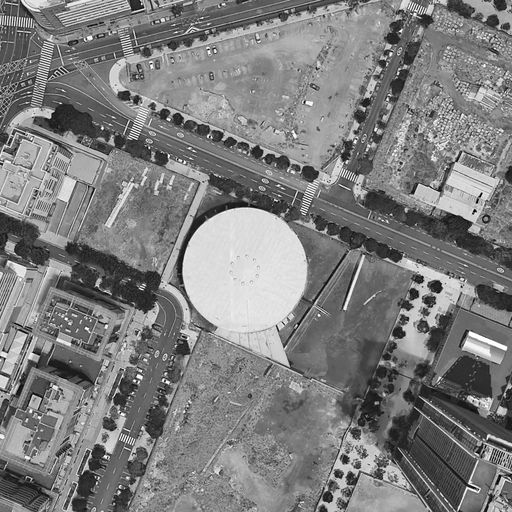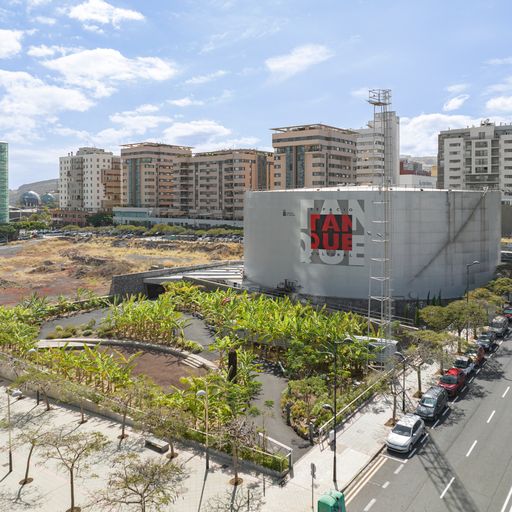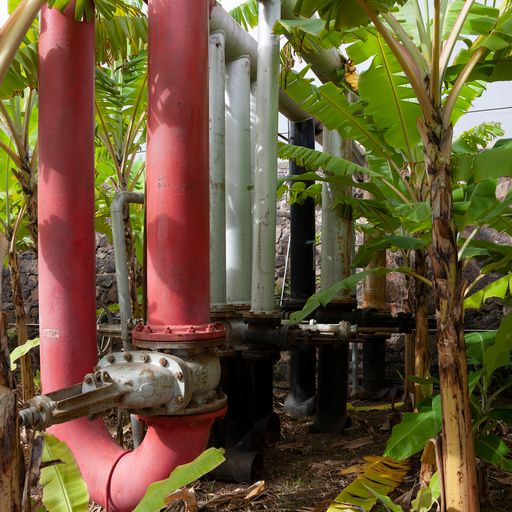

Spanish architect won the Exterior Spaces category for El Tanque Garden of Santa Cruz de Tenerife, the Built Heritage category was won by David Chipperfield for the Renovation of the iconic Neue Nationalgalerie in Berlin.
El Tanque Garden of Santa Cruz de Tenerife won the Exterior Spaces category in the AHI European Awards for Intervention in Architectural Heritage. Designed by the Spanish architect Fernando Menis, this is the ecological restoration of a former industrial area, which has endowed the Cabo Llanos neighborhood with its first green public space. Around a former refinery tank, repurposed as a cultural space since 1997, and listed since 2014, this banana trees orchard recalls the agricultural landscape prior to industrialization, staging the city as a place of coexistence of different eras, cultures and sensibilities that have been shaping its identity.


“El Tanque Garden works with ecology and heritage to offer a creative, cultural and socially inclusive public space. It demonstrates sensitivity on all scales, including the reuse of industrial waste for the design of furniture and lighting”. It is complete in terms of sustainability, social benefits and in relation to local identity and landscape design” – stated the Jury.
The Award in the category of Built Heritage went to the rehabilitation of the Neue Nationalgalerie in Berlin, carried out by the office of David Chipperfield, the last Pritzker winner. In the Urban Planning category, the Jury has awarded the Regeneration of the Gràcia neighborhoods in Barcelona, by the firm Jornet Llop Pastor Arquitectes, together with the Urban Planning Department of the Barcelona City Council. Finally, in the Dissemination category, the Prize has been awarded to the documentary “La vie en kit”, by the Belgian architect and filmmaker Elodie Degavre.
In addition, the non-profit Asociación Amigos del Espacio Cultural El Tanque has been a finalist in the Dissemination category for its incessant activism over 25 years to rescue, defend and protect El Tanque as an element of the industrial and cultural heritage of the Canary Islands.
The Award is a biennial initiative of the Barcelona platform AHI Architectural Heritage Intervention; the Colegio Oficial de Arquitectos de Cataluña COAC (Architects Association of Catalonia ); Barcelona City Council; and the Barcelona Metropolitan Area. In its sixth edition, a total of 241 projects have been entered by architecture firms from 28 European countries, the highest figure ever achieved.
The Cultural Space El Tanque in Santa Cruz de Tenerife is a former refinery deposit, used as a cultural space since 1997:
The El Tanque Cultural Space of Santa Cruz de Tenerife is the former tank 69, a huge container long used for the refining and storage of crude oil that was part of the CEPSA refinery, the first built in Spain around 1930. It is a 20 m high cylindrical piece with a 50 m diameter that represents one of the last vestiges of an industry that, in the last half century, has been part of the urban geography of the Tenerife island.
The adaptive reuse as a cultural space carried out in 1997 preserved its original appearance thanks to a minimal architectural intervention based on recycling. Thus, an old ferry bridge abandoned in the city’s port was upcycled for the access; the entrance door to the space and the interior ramp were built with large metal sheets retrieved from other dismantled containers; and the skylights were made with empty CEPSA barrels adapted to their new use.
The El Garden Tanque is the ecological restoration of a post-industrial area in Santa Cruz de Tenerife:
Coinciding with the preparation of the 25th anniversary in 2022 of this singular cultural space, the non-profit Asociación Amigos del Tanque and the Government of the Canary Islands promoted planting a garden that would cover its surroundings, to produce the first green public space in the neighborhood of Cabo Llanos.
The perimeter of El Tanque has been covered with banana trees as a way of remembering the agricultural activity that existed in this area before the CEPSA refinery was located here in the 1930s. As time passes by the exuberant subtropical vegetation colonizes the industrial relic, framing its fascinating presence while restoring the memory of the agricultural past to build a sense of cultural continuity and belonging.
The new garden respects the original layout and stone wall of the site, while the base of a dismantled adjoining tank is now the perimeter of a new semi-circular plaza. The exterior of the Tank and its elements have been rehabilitated and integrated into the general redesign concept that combines industrial heritage and nature.
Menis’s landscape design seeks to create a highly biodiverse garden based on native flora with more than 700 trees and shrubs, as well as aromatic plantes areas. There are mostly banana trees as a way to recall the banana plantations that grew on the site before it was converted to industrial use.
“Our research work has confirmed that this area was agricultural. There used to be banana and tomatoes, as well as coast plants such as tabaibas, cardones, verodes, etc., all of them native plants of the Canary Islands, which require little watering, are resilient and durable. By looking back into the agricultural history of Santa Cruz, we decided that the area around El Tanque should be planted again with banana trees. And, the tomatoes have simply sprouted, since there must have been vines over 90 years old, incredible survivors of an entire industrial era, which, after having prepared and watered the land, have grown again because the earth, the soil, can recall, although sometimes we forget it”, explains the architect Fernando Menis.



Following the same line of re-use and recycling that he already applied in the rehabilitation of the El Tanque Cultural Space, the architect designs the outdoor lighting and furniture of the Garden with waste. Thus, divers’ oxygen bottles were recovered from the garbage and adapted to be used as lamps. And, since one of the main users of the garden are children, the lamps resemble the Minions, the cartoon characters who are heavy banana consumers. Care for the environmental impact is also perceived in the orientation of the lamp so that it avoids light pollution, as well as in the watering of the greenery, which is supplied with recycled water.
What used to be contaminated and underused land, although part of a protected heritage compound, is now a lush garden that will only improve as biodiversity recovers, offering a public space for social cohesion, reconnection with nature and the cultural heritage of Tenerife.
“In short, it is an action with multiple implications since we have got now an accessible plaza, which is also a new green public space, a first one in the Cabo Llanos neighborhood, the agricultural history of Santa Cruz de Tenerife is evoked and, at the same time, biodiversity is recovered. It is an action that can be an example to ecologically recover other spaces in the city and on the island”, emphasizes Dulce Xerach, a lawyer and president of the Association Los Amigos del Tanque.






El Tanque Garden Facts:
Address: C/Adán Martín Menis s/n 38003 Santa Cruz de Tenerife, Canary Islands, Spain
Completion: 2022
M2 site: 5.714,55 m2 (2.210 m2 garden)
M2 : 2.563,75m2 (environment 1.989,63 m2+ tank 574,12m2)
Cost: 480.086,74 €
Architect: Fernando Menis
Client: Consejería de Educación, Universidades, Cultura y Deportes del Gobierno de las Islas Canarias, Dirección General de Patrimonio Cultural (The Government of the Canary Islands)
Initiative: Association Amigos del Espacio Cultural El Tanque
Design project team: Jesús Montejano, Javier Espílez, Joanna Makowska-Czerska, Yanira León
Consultants: Ruperto S. Hernández González (Technical Architect and Director of building works); Prisma Ingenieros SLP (Building services engineer); Interjardín SL (Gardening); Cristina Saavedra (Logo Graphic Design)
Companies: Señalizaciones VillarPlantas (asphalt); Interjardín S.L (soil and plants); Zumtobel (lighting); Refinería Cepsa (elements for recycled furniture); Eco Steel (locksmith); Hernández de la Guardia (paint); Fachadas Dimurol S.L (painter)
Construction companies: UTE Señalizaciones Villar S.A and Interjardín S.L.
Fernando Menis (1951, Tenerife). Witha professional career spanning more than 40 years, Menis’s architectural production includes works of various scales and typologies, as well as long-term research projects. An expert in designing concert halls and auditoriums, he is internationally recognized and awarded for conceiving an innovative variable acoustics system for the CKK Jordanki Concert Hall (2015, Poland). Among the projects completed, alone and in co-authorship: the Church of the Holy Redeemer of Las Chumberas (2022), El Tanque Cultural Space Public Garden (2022), CKK “Jordanki” Concert and Conventions Hall, in Poland (2015) , Plaza Bürchen in Switzerland (2015), Insular Athletics Stadium (2007), Magma Arte & Congresos (2007), Floating pool in the Spree River of Berlin (2004) and the Presidency of the Canary Islands Government in Tenerife (2000). Among the ongoing projects, the following stand out: the Rehabilitation of the Viera y Clavijo Cultural Park, the Masterplan in Boa Vista, the Pájara Conventions and Concert Hall in Fuerteventura, the Rehabilitation of the Cultural Center in La Guanche, the Rehabilitation of the Teobaldo Power Performative Arts Hall in La Orotava. Distinguished on 10 occasions with the Canary Islands Architecture Prize, Menis also won: the Prize for the Best Cultural Building in Poland 2015 from the National Council of Architects of Poland; the CEMEX Award for Universal Accessibility 2016; the 2016 Taipei Design Award to the Best Public Building Award; the Stone Award at the VIII International Stone Architecture Award 2005; and the Prize of the V Spanish Biennial of Architecture 1998, among others. Architect Doctor from the Polytechnic of Valencia, his works have been shown in several editions of the Venice Biennale, at the Museum of Modern Art in New York, at the Aedes Berlin gallery and the GA gallery in Tokyo. His project Iglesia del Santísimo Redentor is part of the permanent collection of the MoMA Museum of Modern Art in New York.

